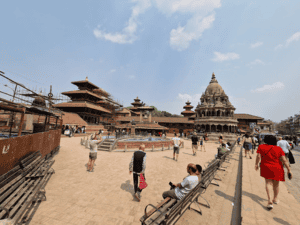
Patan Darbar Square
Patan Darbar Square is an ancient, religious, and historical place in Nepal. It preserves ancient art, culture, and techniques. It is one of the world heritage sites of Nepal. Patan Darbar Square is located in Lalitpur district. Lalitpur is the ancient city of the Kathmandu valley. It is very rich in Newari arts, culture and heritage. Here, majestic palace buildings, artistic courtyards, Boudha Bihar, Stupa and elegant pagoda temples blend in a showcase of classic Newari architecture.
Patan Darbar, Krishna Temple, Bangalamukhi, Rati Machhindranath, Mahaboudha, Rundra Varna Mahabihar, Kumbheshwor, Jagat Narayan, Ashok Stupa, Patan Industrial Estate, Golden Temple and The Living Goddess Kumari are the major attractions of the Patan area. It is one of the oldest cities of Nepal. In history, the Malla Kings ruled in Patan. At that time, those kings promoted the unique arts, culture and heritage in the community. You can experience the unique and ancient arts, heritages and food here.
History of Patan Darbar Square
Patan Palace Square is one of the historical places of Nepal. It has a long historical story. For more than 200 years, the late Malla dynasty had the honor of decorating this square with many beautiful monuments, pillars, and small shrines.
The earliest details of the palace's history are not well-documented. There are many legends and myths regarding Patan. Evidence suggests that this area has been a center of royal power since the first millennium, as shown by a stone inscription from 643 AD in the main courtyard (Keshav Narayan Chowk) of the museum and another from 560 AD at Manidhara, just north of the museum.
The palace that stands now was built by King Vishnu Malla in 1734 AD. Long ago, there was a fort in this area, so the palace's history stretches back many generations. The name “Chaukot” first appears in records from King Siddhinarasimha Malla in 1630 AD, and later, the palace was renovated by King Srinivas Malla in 1674 AD and again by King Vishnu Malla in 1734 AD. Since 1997 AD, the former royal palace has been transformed into the Patan Museum, preserving its rich heritage for all to see.
Major Places in Patan
There are many places to explore in the Patan area. Here is a small list:
Patan Darbar Square
Patan Durbar Square is a UNESCO World Heritage site that once served as the palace of the Patan kings. The government of Nepal preserved this palace as a museum. Today, visitors can explore the renovated Keshav Narayan Chowk, now home to a bronze artifact museum, and admire the detailed woodcarvings and stone sculptures at Sundari Chowk, where a historic sunken bath called Tusha Hiti.
Krishna Mandir
Among the many treasures in Patan is the Krishna Temple, famous for its 21 gilded spires. It was built by Siddhinar Singh Malla in 1637. Constructed entirely of stone, this temple is recognized as one of the first examples of Shikhara-style architecture in Nepal. Nearby, the Manga Hiti (a beautifully carved sunken water spout) is the further highlight of the city’s rich architectural legacy.
Maha Boudha & Rudra Varna
The another attraction of Patan is Maha Boudha. It is in the east of Durbar Square. Maha Boudha is a 14th-century Buddhist monument adorned with exquisite terra cotta art and thousands of engravings of Lord Buddha. Not far from here is Rudra Varna Mahavihar (also called Uku Bahal), a monastery with a stone-paved courtyard and a two-story building with gilded roofs that once crowned ancient kings.
Hiranya Varna Mahabihar
Another notable site is Hiranya Varna Mahavihar. It is also known as the Golden Temple. Dating back to the 12th century, this three-storied shrine is celebrated for its superb wood carvings and metal repousse work, and it houses an impressive image of the Buddha in its courtyard.
Kumbheshwor/ Bangalamukhi
The Kumbheshwar temple is dedicated to Lord Shiva. It is also known as Bagalamukhi. Built in 1392, its courtyard features a natural spring believed to originate from the glacial lake of Gosainkunda in northern Kathmandu, making it a popular site for ritual baths during the Janai Poornima festival.
Jagat Narayan Temple
The Jagat Narayan Temple is located along the banks of the Bagmati River at Sankhamul. It is another architectural gem in Patan. Built with red bricks in a tall Shikhar style and dedicated to Vishnu, it features a striking metal statue of Garuda, along with images of Ganesh and Hanuman.
Ancient Stupas
Four stupas, traditionally attributed to Emperor Ashoka of India around 250 BC, mark the four corners of Patan. Located at Pulchowk, Lagankhel, Ibahi, and Teta (on the way to Sano Gaon), these monuments reflect the era when Buddhism thrived in the Kathmandu Valley.
Pimbahal
It is another major attraction in Patan. There is a beautiful pond. Similalry, tourist can take the boating experience. Pimbahal is the best place for relaxation, with a beautiful pond view.
Entry Fees
Foreign visitors Rs. 1000.00
SAARC visitors Rs. 250.00
Nepalese Visitors Rs.30
Nepalese Students Rs.15.00 (with ID Card/College Letter)
According to the rule of ODFME (One Door Free Museum Entrance).
Note: Entrance Fee for Patan Museum(KeshavnarayanChowk, Mulchowk, Sundarichowk, BhandarkhaalTank and the Architectural Galleries).



